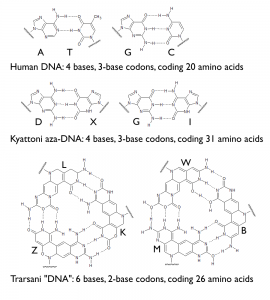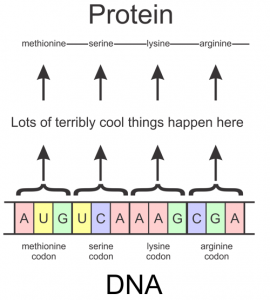2014
May
03
The Population-K Genetic Metacode
It is well-known about advanced civilizations throughout the universe that the various Population-K (humanoid) species have wildly variant genetic codes but an identical genetic metacode. Humans don't know this, but they don't have a particularly advanced civilization. Certain humans, such as Timothy Saugers, Lesley Kellerman, and Erik Sørensen, find it out, but don't really understand what it means, probably because none of them are geneticists or biochemists. So let's run an excursion into genetic biochemistry and make that clear. If you follow me at all, you know I'm pretty serious about the science in my science fiction, so let's get serious one more time.
Genetics Across the Universe
Figure 1 shows how strands of "DNA" are bound together for three Population-K species that either originated on or have set foot upon Earth. All those terms in the figure will be explained below, but for now just notice how different the three are, especially the Trarsani.
One would expect this. There are a blue bazillion ways to put together genetic information and proteins, and as life originated independently on billions of worlds, it would be on the side of lunacy to think that they would all settle upon the same scheme.
One would expect that with different biochemistries on the most fundamental level of life that the people that stem from them would be different in appearance, function, and behavior. For the most part that is true. A vast majority of intelligent species are classified Population-D, and they run the gamut of biological possibility. If you can visualize a beastie, there is probably one like it somewhere in the universe. When two Population-D species resemble each other, it is simply by chance because there are so many of them out there.
But Population-K species are different. There are dense concentrations of them at various locations, often exceeding 50% of intelligent species in those regions, and generally they are indistinguishable by casual outward appearance, far beyond what mere chance would allow. An equal or more neotenous race, with a few exceptions, could appear on another Population-K planet and no one think anything out of the ordinary. How species with totally different genetic makeup can come out of the oven nearly the same is the topic of this post. In certain circles, I identify myself as a physical biochemist, so this stuff is seventh heaven for me. For the rest of you, turn on your geek switches and bear with me.
The Human Genetic Code
Before we even talk about the genetic metacode of Population-K species, we need to understand the genetic code, and for this purpose, we'll restrict ourselves to one planet and talk about DNA (deoxyribonucleic acid) on Earth. If you could look at your DNA really close, you would see that it is composed of various sequences of four bases, two purines (guanine , and adenine ) and two pyrimidines (thymine and cytosine ). We use those letters as abbreviations because it would get gravely monotonous spelling them out all the time. There are two things for you to notice. The first is that the four bases are chained together in endless possibilities by being attached to a long backbone (the squiggly lines in Figure 1). For humans, flatworms, mosquitoes, and ... well ... life on Earth, that is a ribose-phosphodiester backbone. The second explains that "double helix" you've heard about. Each of the four bases pairs up with its matching base on another strand (sort of like a photographic negative, if you're old enough to remember those) and the two strands wrap around each other in spirals.
How all of this makes you alive is that the sequence of bases in DNA is a pattern for making proteins. Proteins are built up a sequence of amino acids with names like "methionine", "serine", "lysine", and "arginine." You remember the "lysine contingency in Jurassic Park? Well, now you know what lysine is. Each group of three bases in the DNA (a codon) programs a single amino acid (see Figure 2). With four possible bases, that gives us 64 possible combinations, but there are a lot of duplicates, so only 20 amino acids are programmed, and a few combinations, called stop codons, mark the end of a protein. Each string of codons that encodes a single protein is a gene. Now you know what a gene is, too, if you didn't already.
Actually, as the image says, there are a lot of really cool things in between DNA and the final protein: messenger RNA, intron removal, transfer RNA, and so on. Then there all all kinds of cool things that happen after the proteins are made, like posttranslational modification, but those are details you can read about on your own as they don't really affect the nature of this post..
In summary, the genetic code is the set of rules for transforming DNA sequences into proteins.
Other Population-K Genetic Codes
Now let's move on to genetic material not native to Earth. The Kyattoni aza-DNA in Figure 1 is almost the same as ours. Instead of two purines and two pyrimidines as bases, it has four purines (guanine , isoguanine , 2,6-diaminopurine , and xanthene ). Yes, that's the same guanine as in Earth DNA, but the others are different. And the backbone is still of the phosphodiester variety. There may be some purists who say that it's not really DNA because there is a nitrogen substitution in the backbone (hence the "aza": deoxy-aza-ribonucleic acid), but I am of the opinion that's just nitpicking. It's DNA.
Of course, since the bases are different, the genetic code can't possibly be the same. There are still codons consisting of three bases, but they're different bases, and they code differently, 31 amino acids in total. Also obviously, the proteins won't be same as ours, either, though the amino acids are all in the same family as ours.
Moving on to the Trarsani is where it really gets interesting. It's not DNA at all, which is why I put it in quotes in Figure 1. Neither purines nor pyrimidines, but rather a group of bases that have no particular name among Earth scientists, and instead of hydrogen bonding in pairs, it's in triplets. The letter names assigned to the bases derive from the Trarsani names and there is little point in trying to translate them. The base triads are nominally planar, with a tendency to buckle a little at the hydrogen bonds, but they get flattened out by stacking when the whole molecules are put together. Furthermore, there are no phosphodiesters. The backbone is a pyrrole-imidazole polyamide. In other words, there is nothing here remotely resembling Earth-type DNA except the hydrogen-bonding groups.
With six bases to work from instead of twelve, you don't need as many to code an amino acid. Trarsani codons consist of only two bases, which would yield 36 combinations, out of which 26 amino acids are coded.
With this much variety across the universe, we should not be surprised to find just as much variety in anatomy. Why the Population-K species are almost identical leads us into the genetic metacode.
The Genetic Metacode
At this point, we know that one gene produces one protein. Proteins can be either structural (building up tissue) or enzymatic (catalyzing chemical reactions). There is nothing here so far to explain why some cells become liver cells and others bone cells when they all have the same DNA, or how our bodies develop into the particular shapes they have. All we have are ... proteins.
To describe what is happening here, we really need the term gene expression. A gene is expressed when a protein is made from it, but genes are not always expressed. Our DNA is full of genes that aren't expressed. Furthermore, the expression of genes can be turned up or down, not just on and off. The level of gene expression determines how much of a protein is produced, and the levels of various proteins determine how cells develop. There is a complex interacting control system that programs how genes get expressed so that cells develop as they should. As an organism grows from a fertilized egg, chemical messengers start flowing around that say things like this: "Turn up the genes that cause these cells to be muscle cells," "Accelerate growth here and here so that arms develop," and "Oh, these cells need to be bones, and express the genes this way so that they grow in the right direction."
Humans have some general ideas how all this works, and know the details of a lot of the control signalling paths, but are a long way off from having the entire system mapped out. But not so other species in the universe like the Trarsani, the Kyattoni, and the Kria-Ki. They had all this in their databases before humans invented clothing (and that was a long, long time ago) and this is what they found out. For all the Population-K species, even through genes are encoded differently and proteins are assembled differently as one would expect from independent evolutionary processes, that network of gene expression control is identical. (Several exclamation marks should go here, in case the impact of that last statement eluded you.)
The genetic metacode is the set of rules for controlling gene expression to convert the genetic code to a complete organism. Don't bother Googling it; you'll get stuff about computer programming.
The Metacode Mystery
Why there are so many genetic codes throughout the universe is rather a no-brainer. Why in most cases — the Population-D races — that translates into an astronomical variety of life forms is also a no-brainer. But why there is a single genetic metacode for thousands of Population-K races is something the Trarsani and others gave up trying to solve more than 80,000 years ago.
Naturally, there were a number of hypotheses suggested, ranging from inevitability under certain conditions involving primate-like mammals, to a technically advanced civilization, to God. However, all of these were abandoned either because of lack of supporting evidence or evidence to the contrary. In the end, they concluded that they didn't have so much as a clue as to what is behind the metacode puzzle, and deferred solving it to sometime in the future — say, a million years.
The Hamoni community on Arcora, though without the advanced scientific knowledge of the Triumvirate at the peak of their civilization, call it the "second biggest mystery in the universe." Actually, it's much bigger than the first.
Book Connections
The genetic metacode is first mentioned in Korvoros.
The Trarsani triple-helix "DNA" becomes significant in A Hierarchy of Gods.
The differences between human and Kyattoni DNA is mentioned in The Humanity Experiment.
The nature and purpose of the Population-K genetic metacode and DNA cross-coupling is approached in Labyrinth of Space.
The whole secret finally reveals itself in Tetragrammaton.
Real-World Science Connections
I'm hoping you find all this interesting because, frankly, if you don't, you should consider therapy. It's an awesome topic! Unfortunately, the papers I list here might be hard for a lot of people to get. Yes see, humans apply quite a bit of computer technology to actually keep people away from science research. We call it a pay wall. Unlike the advanced nodal races, humans invented money, which led them to the Dark Side in virtually all endeavors. But if you can get to these papers, enjoy.
On purine-only DNA
Arenz, C.; Seitz, O. "DNA made of purines only", Chem. Biol. 2007, 14, 467–9.
Battersby, T. R.; Albalos, M.; Friesenhahn, M. J. "An unusual mode of DNA duplex association: Watson-Crick interaction of all-purine deoxyribonucleic acids", Chem. Biol. 2007, 14, 525–31.
On aza-DNA
Yokoyama, M. "Synthesis and Biological Activity of Azanucleosides" Synthesis (Stuttg). 1999, 1999, 1541–1554.
On triplex DNA
Frank-Kamenetskii, M. D.; Mirkin, S. M. "Triplex DNA structures", Annu. Rev. Biochem. 1995, 64, 65–95.
Limongelli, V.; De Tito, S.; Cerofolini, L.; Fragai, M.; Pagano, B.; Trotta, R.; Cosconati, S.; Marinelli, L.; Novellino, E.; Bertini, I.; Randazzo, A.; Luchinat, C.; Parrinello, M. Angew. "The G-triplex DNA", Chem. Int. Ed. Engl. 2013, 52, 2269–73.
On pyrrole/imidazole polyamides and DNA
Dervan, P. B.; Edelson, B. S. "Recognition of the DNA minor groove by pyrrole-imidazole polyamides", Curr. Opin. Struct. Biol. 2003, 13, 284–299.
Credit where it's due: much of the knowledge and imagination behind this post came from Dr. Seth Horne's Chemical Biology class at the University of Pittsburgh, which remains the coolest class I took in grad school. And that includes quantum mechanics. In all fairness to myself, though, the general idea predated that by decades.

















Comments
There are no comments for this post.
You must be logged in to post a comment.